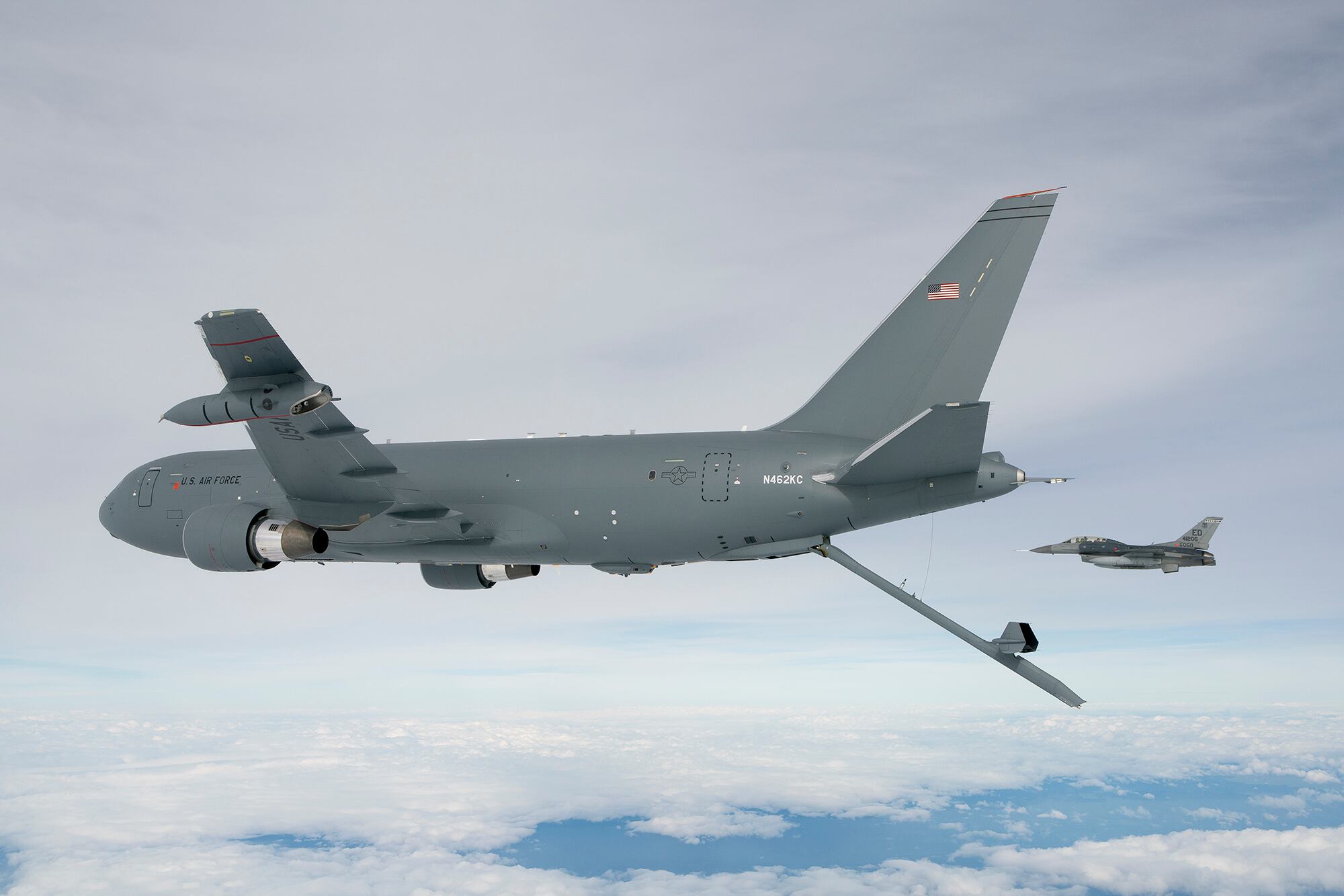WASHINGTON and KADENA AIR BASE, Japan — The U.S. Air Force’s fleet of legacy tankers and cargo planes may be getting some major survivability upgrades over the next decade, with lasers and autonomous systems on the table, the head of Air Mobility Command said Tuesday.
Air Mobility Command recently completed an assessment about how to improve the survivability of aircraft in contested environments, Gen. Carlton Everhart, the four-star in charge of AMC, told reporters. While more work still needs to be done to figure out exactly which modifications the Air Force will fund and when, the “High Value Airborne Asset” study recommended improvements to communications, situational awareness and self-protection systems.
“Those technologies are out there right now,” he said. “We’re just at the infancy stages of starting to peel that back. How does that fit on the airplane? Do we need to modify the airplane? How does it work? What can we do to make this better?”
The area of self-protection systems perhaps offers the most diverse technologies for the Air Force to pick from or develop further, with Everhart pointing to everything from light armor, signature management tech or high-energy lasers as potential interests.
“We just had a directed-energy summit where we’re really taking a look at exploring defensive systems that we may be able to piggy back on contracts. That’s in an exploratory phase,” he said. “That would give them persistence over a battlefield.”
The command will also consider whether to equip tankers and airlift assets with nondevelopmental radar warning receivers. And AMC is searching for additional beyond-line-of-sight communications, he said. AMC will be looking at data links commonly used by the bomber and fighter fleets, like Link 16, and how to better network with the service’s air operations center.
When Link 16 was being developed, AMC didn’t think its aircraft needed that or other kinds of advanced communications technology, Everhart explained. However, the ability to better understand the threats around an aircraft and communicate with other Air Force assets in the area could greatly bump the chances of an older platform like the 1950s KC-135 Stratotanker surviving a battle with a near-pear competitor.
“If I can get the situational awareness up inside the cockpit where the aircrews can make a decision whether to hang on or all out for a CAP [combat air patrol] to come in and protect that aircraft or to retrograde out, that’s a whole lot further than what I’ve got now because right now I have nothing. Right now it’s a … radio,” he said.
The Air Force plans on requesting a total of $49.2 million over fiscal 2019 and fiscal 2020 for a KC-135 upgrade called “Real Time in the Cockpit,” which aims to provide protected, classified data connectivity. Other requests for funding survivability upgrades will likely emerge in the next five to 10 years, once AMC formalizes its requirements, Everhart said.
RELATED

Going forward, the command will also assess whether its newest platform, the KC-46 tanker due for delivery this year, could benefit from enhancements — including making it more autonomous, he said.
“As that airplane continues to develop, is there a possibility for autonomous mobility platforms? That’s going to be able to offboard and onboard communications just to be able to get that aircraft to fly and be able to fly. And that’s a possibility in the future.”
The High Value Airborne Asset study was led by AMC, but could also have implications for aircraft outside of the air mobility fleet. Everhart told reporters that Air Force Global Strike Command and Air Combat Command, which oversee the service’s bomber and strike assets, also participated in the assessment.
During a trip last week to Kadena Air Base, located on the Japanese island of Okinawa, Defense News asked KC-135 operators whether survivability upgrades — such as defensive systems, high-energy lasers or a radar signature disguising devices for which Everhart had previously expressed interest — would be beneficial for the Stratotanker fleet.
“I would have to defer to the war fighter on [if those upgrades would be] useful and helpful,” said Lt. Col. Garrett Bilbo, commander of the 909th Aerial Refueling Squadron. “Would it be neat and innovative and a better way to do business? I’d say ‘yes.’ ”
Capt. Ty Burgess, the squadron’s director of staff and a KC-135 pilot, said that survivability upgrades could be nice, if that’s what Air Force leadership deems necessary. However, Burgess said he was still happy with the aircraft’s performance despite its advanced age, and indicated that he felt comfortable with the Stratotanker’s current level of survivability.
“We’re not like, ‘Oh, my gosh, I need a new X.’ That’s just not the case with this airplane,” he said.
“As far as what I want, I want an airframe that keeps on flying and flying well. Whether that’s round dials and gauges, if that’s what’s working and that’s survivable and a long-term solution, awesome. If that’s LED screens and glass cockpit, that’s fine, too.”
Valerie Insinna is Defense News' air warfare reporter. She previously worked the Navy/congressional beats for Defense Daily, which followed almost three years as a staff writer for National Defense Magazine. Prior to that, she worked as an editorial assistant for the Tokyo Shimbun’s Washington bureau.







